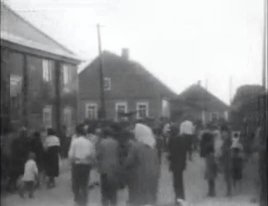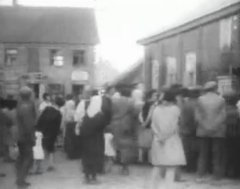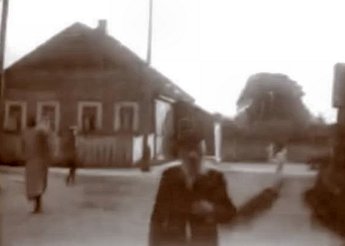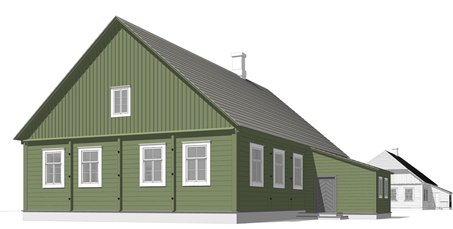 |
Rokiskis’ Synagogue Street – Images and Informational Sign |
|
A 10 minute and 31 second collection of
“home movie” segments taken during a trip to Lithuania before the Second
World War has been posted by Hebrew University’s Spielberg Jewish Film
Archive at
https://www.youtube.com/watch?v=Wv3CZSCdxXc.
Scenes
of Rokiškis appear between 04:15 and 06:20.
The scenes include, among other things,
a major market day on Independence Square, an outdoor wedding on the
steps of the largest of the three houses of prayer on Synagogue Street (Sinagogų
gatvė),
a Lag Ba’Omer parade, the Tyzenhaus mansion, and a people bathing in
Lake Vyžuona.
Three houses of prayer stood on the south side
of Sinagogų gatvė.
When
Lithuania was independent, they were painted, respectively, in the
colors of the national flag, namely, red, green, and yellow.
The
two-story Great Synagogue (“Graiseh Shul”), which stood at the corner of
Sinagogų gatvė and Respublicos gatvė (Republic Street, formerly, Kamai
Street), was painted red and was known as the red synagogue.
It was also known as the
“Alte Shul” (the “old” shul).
All three were burned in July 1941.
In 2015, Giedrius Kujelis, the
assistant director and historian of the Rokiškis Regional Museum, made
the following several “still” pictures from the video segments showing
the Synagogue Street area.
Lithuanian
architect Aurimas Širvys, a native of Obeliai / Abel, used the pictures
to create three-dimensional images that were incorporated into an
informational sign that was installed on Synagogue Street in September
2015.
Still Image 1 – Synagogue Street view, looking
west-southwest.
The Great Synagogue is on the left and
the green synagogue is in the center background.
The people are gathering for a wedding.
A chuppah is seen in the middle of the
picture.
Still Image 2 – Synagogue Street view, looking
east-southeast toward Republic / Kamai Street.
The Great Synagogue is on right.
The building on the left once housed
the Folksbank (Jewish People’s Bank) and was still standing in 2016.
A wooden building on the northwest
corner of the intersection (off camera) was the home of Reb Betzalel
Katz.
From the still images, Lithuanian
architect Aurimas
Širvys created these representations of
the three synagogues for the informational sign that now stands on
Synagogue Street.
The Great Synagogue – for the general community
The Green
Synagogue – for community leaders
As noted above, in 2015, Giedrius
Kujelis, the Rokiškis Regional Museum’s historian, and architect Aurimas
Širvys began work to design an informational sign that would describe
the three synagogues that stood on Synagogue Street until 1941.
The sign is written in Lithuanian,
English, and Yiddish.
Among those assisting with this project
were Remembering Rakisik Jewry,
LLC, and its parent, Remembering Litvaks, Inc.; Linda Cantor, the
chairman of the
Rokiškis Special Interest Group of Jewish
genealogists; and American author Ellen Cassedy, who led a group of
volunteers from Vilnius University’s Yiddish Institute.
The sign was dedicated by Rokiškis
Mayor Antanas Vagonis on September 6, 2015, which that year was the
European Day of Jewish Culture.
Credit:
Philip S. Shapiro
Speech of Mayor
Antanas Vagonis
Upon the Dedication
of the Informational Stand
On Synagogue Street in Rokiškis,
Lithuania, September 6, 2015
(English Translation)
First of all, I would like to thank the coordinators of our
[Rokiskis Regional] museum, who undertook this nice initiative.
As you know, the process of reviving Jewish symbols began a very
long time ago. And not long
ago, when I myself was working for the municipal public works council,
the sculptor, Albertas Jasiūnas, told me that he would need help in
installing the memorial stone near the gates of the Jewish cemetery.
And I told him that we would help, that it would not be a
problem, that we could do it quickly, and that there would be no charge
at all.
As you know, historically, and my advisor made some research,
some time ago there was a large Jewish community [in this town], and the
Jewish residents even outnumbered the Lithuanians.
It is very well said that we need to revive historical things.
And today I want to touch upon the subject of bridges.
Bridges serve not only for remembering and showing these
[cultural] features but those bridges should also serve to invite people
to come back over these bridges.
I know that our ethnic groups have been put into confrontation, and not
just for one year. And for
some things we should feel ashamed before your nation and some other
nations. And we are
constantly being put into confrontation with the Russians, and with the
Poles, and even with our neighbors the Latvians, let alone the Jews.
We have to look at things the way they are now and think.
There are no bad peoples, maybe only bad leaders of those
peoples. It is not the
fault of the Russians that they have such a leader as Putin, it is
understood. Neither is it
the fault of the Latvians or the Jews that they have been singled out.
Indeed, every nation has an outstanding personality.
We are expressing our joy that you have not forgotten us.
And I want to say more:
Send a message to the whole world that if someone is longing for
and would like to get back to their Motherland, we are looking forward
to your coming back.
….
And I believe that, step by step, we have to come back.
And, on my behalf, I promise, that our people will treat all
nations with respect – with great respect.
And now, I thank you, all, and I thank everyone who worked to
make this beautiful informational sign.
(Translated by Aldona Shapiro) |
| Back to Yiskor Plus Page |
| Back to Main Page |






